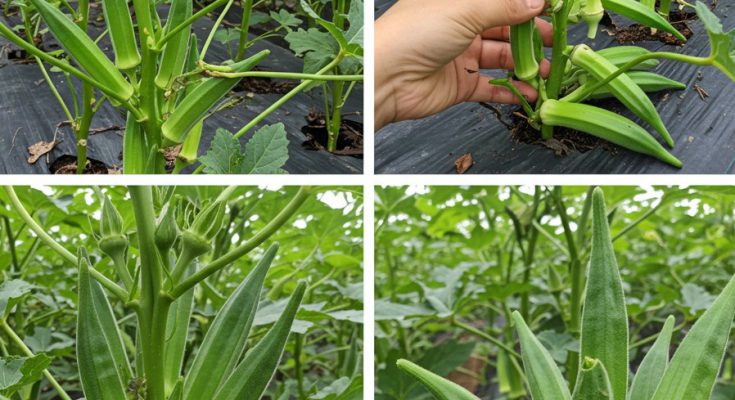A New Way to Grow Okra for Maximum Fruit Production
Okra is a warm-season vegetable known for its edible green pods and beautiful flowers. It’s relatively easy to grow and thrives in tropical and subtropical climates. However, many gardeners struggle to get consistent, high yields, especially when planting in limited space or poor soil.
Fortunately, there’s a simple, innovative method that can help you grow okra with abundant fruit—even in containers or small garden plots. This technique focuses on strategic planting, pruning, and soil improvement to encourage strong plant growth and prolonged fruiting.
Here’s a step-by-step guide to growing okra in a way that maximizes both yield and plant health.
1. Choose the Right Variety
Not all okra is the same. To get heavy fruiting, it helps to start with high-yielding or hybrid varieties that are bred for performance. Look for seeds labeled as “prolific,” “heavy fruiting,” or “dwarf hybrid,” especially if you’re working with limited space.
Some popular productive varieties include:
-
-
Clemson Spineless
-
Emerald
-
Jing Orange
-
-
Burgundy
-
Nombo Giant (for large pods)
2. Prepare Rich, Loose Soil
Okra loves soil that is:
-
-
Well-drained
-
Loamy or sandy
-
-
Full of organic matter
Before planting, mix compost, aged manure, or worm castings into the soil to boost fertility. Okra doesn’t like heavy, compacted clay, so loosen the soil to a depth of 12–18 inches to allow the roots to grow deep.
If planting in containers, use a mix of:
-
-
50% garden soil or cocopeat
-
-
30% compost
-
20% sand or perlite for drainage
This blend ensures strong root development and better nutrient absorption.
3. Use Raised Beds or Bags for Better Growth
Growing okra in raised beds or large grow bags can dramatically improve yield. This method helps with:
-
-
Better drainage
-
Improved root aeration
-
Easier pest control
-
-
Warmer soil temperatures
Use bags that are at least 15 inches deep and wide. For raised beds, keep spacing at around 12–18 inches per plant to give each okra room to flourish.
4. Planting and Sunlight
Okra thrives in full sunlight, so make sure your garden or balcony spot receives at least 6–8 hours of direct sun daily.
-
-
Soak okra seeds overnight to speed up germination.
-
-
Sow seeds ½ to 1 inch deep.
-
Keep the soil consistently moist until the seedlings sprout (usually 4–7 days).
Once the seedlings grow 4–6 inches tall, thin them to one plant per spot to reduce competition and promote stronger growth.
5. The Secret: Pruning and Topping
Here’s the new technique that many growers are using to increase okra fruit production: topping and pruning.
When your okra plant reaches about 12–15 inches tall, snip off the top growing point using clean scissors or fingers. This may seem counterintuitive, but topping encourages the plant to develop side branches, which can also bear fruit.
Benefits of topping:
-
-
More branches = more fruiting points
-
Bushier plants that are easier to manage
-
-
Delays early flowering, giving the plant time to grow stronger
You can also prune any yellowing or lower leaves once the plant matures to improve airflow and reduce disease risk.
6. Feed Regularly with Organic Fertilizer
Okra is a heavy feeder during fruiting. To keep it productive:
-
-
Add compost or organic fertilizer every 2–3 weeks.
-
-
Use banana peel tea, diluted fish emulsion, or fermented plant juice for natural nutrients.
-
Water deeply 2–3 times a week, depending on heat and rainfall.
Consistent feeding helps the plant sustain a long fruiting season.
7. Harvest Often to Encourage More Pods
One common mistake is waiting too long to harvest okra pods. Mature pods become tough and fibrous quickly, which can also signal the plant to slow down production.
-
-
Harvest pods when they are 2–4 inches long and still tender.
-
Pick every 1–2 days during peak season.
-
Use clean scissors or gently snap the pods off by hand.
-
The more frequently you harvest, the more your okra plant will produce.
8. Pest Control and Maintenance
Okra is generally hardy, but it can be affected by:
-
-
Aphids
-
Mealybugs
-
-
Whiteflies
Spray a mix of neem oil, dish soap, and water weekly if pests appear. Also, keep weeds in check and ensure good air circulation around your plants.
Final Thoughts
With just a few smart changes—like topping, growing in bags or beds, and feeding organically—you can transform your okra garden into a high-yielding, low-maintenance success. Whether you’re planting on a balcony, in a small yard, or on a rooftop, this method is easy to adapt and incredibly rewarding.
Give it a try and enjoy weeks of fresh, homegrown okra—crisp, green, and full of flavor!
